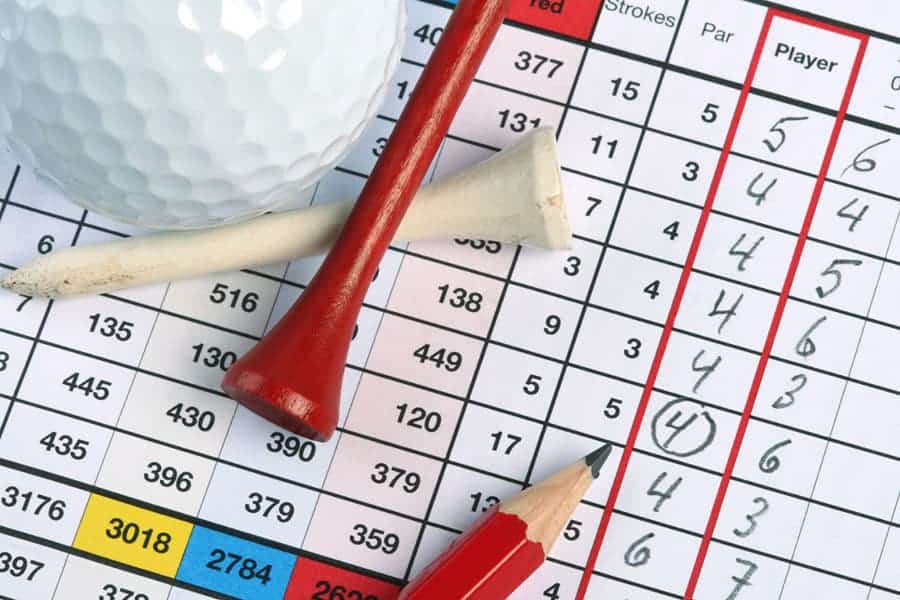How To Read Golf Scorecard: The Basics Of Golf Scoring

For a successful golf game, you must know how to read the scorecard. This article explains the abbreviations, symbols, and numbers on a golf scorecard.
Are you ready to get an edge on your golf game? Understanding how to read a golf scorecard is key if you want to be successful in the sport. Not only is it important for keeping track of scores during a round, but it also provides helpful insight into where improvements can be made to get better at golf game.
If this is something that you’re unfamiliar with, no worries! We will explain exactly what all of the abbreviations, symbols, and numbers mean on a golf scorecard.
How to read golf scorecard?
Being able to read a golf scorecard is key to understanding the game and keeping track of your progress.
Here’s a step-by-step guide:
- Look for the player’s name. This will be listed first on the scorecard.
- Find the player’s current golf score. This will be listed next to their name.
- Look for the player’s score for each hole. This will be listed in order from left to right, starting with the first hole played.
- Find the player’s total score for the round. This will be listed at the far right of the scorecard.
- Repeat steps 1-4 for each player on the scorecard.
Now that you know how to read a golf scorecard, let’s see how to calculate your score.
What Appears On A Golf Scorecard: Explanation
Let’s explore individual elements on a golf scorecard in a little more detail. This will help you understand them better and use this information to better your own game in the future.
Players’ Information
At the top of a golf scorecard, you will find the name and current golf score, and handicap of each player. This is important information to know so that you can follow along with the game and see how everyone is doing.
Hole Information
On the left side of the golf scorecard, you will find information about each hole from one through eighteen. Beneath this is usually the par for each hole. This information is important to know so that you can plan your game accordingly.
Yardage
Just below the hole information, you will find some numbers. These numbers represent the yardage from the tees to the greens.
Par
Par refers to the number of shots that a scratch golfer should take to complete the hole. It is important to know the par of each hole so that you can gauge your own performance.
The numbers listed under the par section will range from 3 to 5. This means that the player who is playing for a par 3 hole should take 3 strokes to complete the hole; on a par 4 hole, they should take 4 strokes, and so on.
The individual holes have a minimum and maximum length and need to be in order to fall into each category.
For men
- Par 3 – minimum – 0 yards to maximum – 260 yards
- Par 4 – minimum – 240 yards to maximum – 490 yards
- Par 5 – minimum – 450 yards to maximum – 710 yards
- Par 6 – over 670 yards
For women
- Par 3 – minimum – 0 yards to maximum – 220 yards
- Par 4 – minimum – 200 yards to maximum – 420 yards
- Par 5 – minimum – 370 yards to maximum – 600 yards
- Par 6 – over 570 yards
Handicap/Stroke Index
Handicap refers to an estimate of the player’s performance on the golf course. For instance, a handicap 6 player would require to shoot 6 strokes over par on a hole in order to finish with an even score. This number is useful for players of different skill levels to compete against each other and calculate the scores in case both individually and in competition.
Tee Colors
The scorecard may also display tee colors. You may notice blue tee boxes, white tee boxes, yellow tee boxes, or red tee boxes.
Generally, the blue tee boxes represent the professional championship golf courses tees, the red tee boxes for beginners, juniors, and women, the yellow tee boxes for in between beginner and advanced while the white tee boxes are for men tees or for better players.
However, this information is not mandatory these days and is not displayed often in some courses as they just name them.
Slope rating/course rating
These ratings are related to the difficulty of a golf course. The higher the slope rating, the more difficult the golf course is.
In, Out, Total
These terms represent the two nines on the golf, the IN is the back nine and OUT is the front nine. You need to put your totals for the two nines in these two boxes labeled in and out. At the end of this is the total score column for the sum of the front and back nine scores.
Hole Layout
The hole layout is more advanced scorecards that will give you hole layout of each hole. The layout will also give you a general idea of where are sand traps or water hazards or the greens. This gives you advantage from playing a hole blindly and missing a shot.
Pin Position
Some golf courses provide you small picture of greens rather than giving a hole layout. The green is further divided into 3 to 4 sections and each section is numbered. The numbered sections represent where the different pins are placed in the location. So, if you want to hit shots closer to hole, then you need to know where the pin is placed.
Net score
You will also find the net scoring information for each player. This includes the player’s score for each hole, as well as their total score for the round. This information is important to know so that you can see how you are progressing and where you need to improve.
Scorer, Date, Attest
At the bottom of the scorecard, there is some space for a scorer, attest and date. The players keep record of each other by swapping the cards. Example: Golfer A keeps Golfer B’s score, and vice versa.
In competitions, the person who is holding and writing scores throughout the round signs the card as a scorer. Moreover, the individual’s playing partner then attests and signs the card. Lastly, there’s a date section to note the date the round was played.
At any professional golf tournament or junior, players must go to scoring immediately following their round to sign and attest one another’s scorecards before the rounds become official and further no more changes can be done.
Local Rules
In some cases, you’ll find local rules noted on a scorecard. These rules are specific to a golf course that are extensions or adaptations of a USGA rule. Local rules can include specifics such as drop rules or out-of-bounds on a particular hole.
Tips to Mark a Golf Scorecard
1. Basic Stroke Play: Record the number of strokes you take for each hole and the total for the round.
2. Match Play: Record the holes you win and lose against your opponent, and the total holes you win after the round is completed.
3. Stableford Scoring System: In Stableford, points are awarded based on the number of strokes taken on each hole in relation to par. The higher your score is compared to par, the more points you will receive. At the end of 18 holes, the golfer with the most points wins. Calculate your score based on the number of points you score per hole.
4. Mark Any Penalties: If you incur any penalties during the round, make sure to record them on your scorecard.
5. Review Your Scorecard: At the end of the round, review your scorecard to make sure it is accurate.
6. Record Your Handicap: Your handicap should be calculated after each round and recorded on your scorecard.
7. Sign Your Scorecard: Always sign your scorecard after you have completed your round.
Understanding golf scorecard symbols
Apart from information like score, handicap, par, yardage, and so on, you will notice a few symbols on the golf scorecard. It is important to understand the meaning of these symbols so that you can follow along with the game.
- The Solid Circle: Eagle, or a good score.
- The circle: Birdie, which is a very good score.
- No symbol: Represents a par
- The Solid square: Bogey, which is a fairly bad score. Usually, one over par.
- The Square: Double Bogey represents two over par.
How to calculate your score in golf?
While the game can be played for fun, it can also be quite a competitive game. If you are interested in keeping score while playing golf, there are a few things that you will need to know.
First, each hole on the golf course is assigned a par, which is the number of strokes that a skilled player should be able to complete the hole. For example, if a hole has a par of four, it means that a skilled player should be able to complete the hole in four strokes.
As a general rule, par-3 holes are the shortest, while par-5 holes are the longest. Once you know the par for each hole, you can begin keeping track of your score. To do this, simply count the number of strokes that you take on each hole and then add up your total at the end of the round.
To keep things fair, most golfers use what is known as “stroke play” scoring. This means that if two golfers have completed the course in the same number of strokes, the one who had the lower score on individual holes will be declared the winner. There are other ways to score in golf as well, but stroke play is the most common.
What Is SSS On A Golf Scorecard?
SSS stands for Standard Scratch Score and is used to measure the difficulty of a golf course. It is calculated by adding the Course Rating and the Slope Rating for the tees being played. The SSS is used to calculate the handicap allowance for players at different golf courses.
The SSS is usually displayed on the scorecard of the course and is used to help golfers determine their handicap and the number of strokes they need to play the course. For example, if a golfer has an 18 handicap, they will need to subtract 18 strokes from their SSS score to get their score for the round.
How to understand the scoring system?
It can be difficult to understand the scoring system of golf if you are new to the game. We have already noted how in golf, each hole is given a par score, which is the number of strokes that a player should ideally take to complete the hole. So, in golf lingo, if a player takes more than four strokes to play a 4-par hole, they are said to have “gone over par.“
Similarly, if the player finishes the hole in three strokes or less, they are said to have “gone under par.” The goal of the game is to have the lowest score possible at the end of eighteen holes.
Players keep track of their scores by writing them down on a golf scorecard. For each stroke that is taken, the player simply marks down their score for that particular hole. For example, if a player takes five strokes on a hole with a par score of four, they would mark down a “5” on their golf scorecard.
At the end of the game, players add up their total score for all eighteen holes. The player with the lowest total score is declared the winner.
Do you know that you can use the scorecard to improve your shots of winning the game? So, let’s learn how.
How to use the scorecard to improve your game?
Golf is a game that is often said to be more difficult than it looks. One of the keys to playing a successful game of golf is to learn how to use the scorecard.
Most standard golf courses have an 18-hole layout, with each hole being assigned a par value. The object of the game is to complete the course with the lowest possible score. However, simply keeping track of your golf score is not enough to ensure success on the course. You must also learn how to use the scorecard to your advantage.
One way to do this is to use the scorecard as a way to keep track of your progress. Each time you finish a hole, take note of your score and then compare it to your previous scores.
If you see that you are improving, it will give you a boost of confidence and help you stay focused on your game. On the other hand, if you see that your scores are slipping, it will be a reminder that you need to step up your game.
In addition to tracking your progress, you can also use the golf scorecard to help make strategic decisions on the course. For instance, if you are playing a hole that is known to be difficult, you may want to take a more conservative approach to avoid going over par.
Alternatively, if you are playing a relatively easy hole, you may want to take a more aggressive approach to try and get under par.
Conclusion
Now that you know how to read a golf scorecard, you’ll be able to follow along with any golf game and understand what’s going on. The great thing about golf is that it’s a sport that anyone can enjoy, regardless of skill level.
So whether you’re a seasoned pro or just beginning your golf journey, remember to take a look at the scorecard now and then – you might just learn something new about the game.








